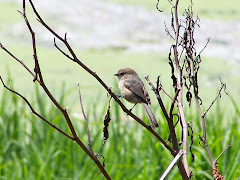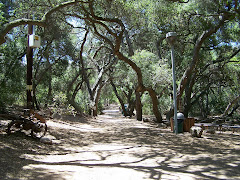
Stormy morning at Bolsa Chica Ecological Reserve.
When I woke up, it was raining. In a moment of weakness, I thought, "Should I go birding in the rain?" It was only a momentary weakness. What's a bit of rain to a birder? So of course, my answer to myself was "Yes, I should, I can, and I am going birding." And the AccuWeather site said the rain was about to stop. So I got ready, rain or not, and headed out to Bolsa Chica Ecological Reserve. There was a very damp Osprey on the light post outside the parking lot that I noticed as I pulled in. He looked wet and miserable. I checked him out, and kept up a brisk pace into the reserve to warm up. It was so beautiful with the with masses of dark storm clouds over the gray water. But boy, was it cold! I kept going, hoping my fast pace would generate heat and scanning the pickleweed for the American Bittern that keeps popping up in the Rare Bird Alert. I'd seen him before, but I wanted another chance.

A Long-billed Curlew and several Marbled Godwits make a knobby kneed line up on the shore.
At first, there did not appear to be much to see.

A bedraggled Belding's Savannah Sparrow forages in the shrubs and pickleweed with a flock of equally wet comrades.
A small flock of Belding's Savannah Sparrows, looking wet and cold, foraged in the pickleweed and the undergrowth at the edges of the pickleweed. They flittered here and there, landing on scattered pieces of branches and on pickleweed, and then dropping back down to the wet ground. How cold must they be with their little bare feet on the cold, wet ground? I hear they don't have much feeling in their feet, but I am still glad that I am not a bird today.

Huddled group of Snowy Egrets at the bottom of a bank which gives them some protection from the wind.
Then I came across about 15 Snowy Egrets puffed up and scrunched down to keep warm. They were down at the bottom of the bank that fell away from the path to the water. It was shelter from the wind.

The Snowies long necks were hidden in their feathers as they fluffed and conserved heat on the cold rainy morning.
They made me feel even colder.
Another huddled Snowy.
Brrrr. I hot-footed it back to the back toward the Wintersburg Channel and the flooded area in the back. Wanted to get into the back area and see what was happening.
In the back--by the Wintersburg Channel--there is an area that flooded a some years ago, and the trees have died. But in nature nothing is wasted. Those dead trees now provide perches for all kinds of birds:
Osprey,
American Kestrels, Red-Tailed Hawks,
Red-Shouldered Hawk, Belted King Fishers,
Black Phoebes, Peregrine Falcons,
Great Blue Herons, and much more. The waters that flooded the area provide lots of shallow water for ducks, herons and egrets and other shore birds. It is a great place to bird watch. The nearby Wintersburg Channel is very eroded, and officials are worried that it may give way in a heavy storm. Read about it
here. The repair will be very costly. Lots of tax dollars to fix the channel.
 Ears.
Ears.
As I watched the ducks and shorebirds, something that looked different caught my eye. Up on the bank above the back water just above me, I saw something large and brown moving. I looked up and saw a set of furry ears. Then a coyote moved out of the undergrowth. Then another. I decided to move away from the coyotes coming down the bank, and started heading up onto the mesa.
 The rest of the coyote. One of two on the bank above the back water after 9AM in the morning. Hungry after night and early morning rain.
The rest of the coyote. One of two on the bank above the back water after 9AM in the morning. Hungry after night and early morning rain.
A lady, against all rules on the many posted signs, was walking her wet dog who had evidently been swimming which was also against the rules. He was off leash and headed for the coyotes. I said to her, "There are some coyotes here." And pointed. She seemed to think they were far away. I told her, "No, they are right here and coming this way." Then she began calling her dog with more urgency. The dog-walking problem is getting bad again here. Don't these people realize that there is a
dog park very close by at Central Park and also at the
Huntington Dog Beach. Don't they realize that there are wild animals here that make walking your dog on or off leash dangerous? A dog can make a tasty snack. Plus the owner can get fined. Some people don't have a lick of sense. What is it about "No Dogs Allowed" that they do not understand? This rule includes the Bolsa Chica area by Wintersburg Channel and the mesa. No dogs. For the safety of the wildlife and the dogs. Grrrr. rant over.

This coyote is one of the many reasons dogs are not allowed at Bolsa Chica and why children should be closely supervised and not allowed to run off by themselves.
As I started to go up onto the mesa, I came face to face with a coyote. I stayed still, and he stayed still, then sauntered away. There seemed to be lots of people up on the mesa, so after a decent interval, I went up, but he was still there. I heard later that he and the second coyote had had some encounters with dogs on the mesa. It is good to keep in mind that coyotes can run up to 40 miles an hour and can leap 8 foot fences. Read more about this and how to react to coyotes from the Newport Bay Naturalists and Friends
here.
He left after giving me the once over.
I went to the look-out. There below me were the wetlands, Pacific Coast Highway (PCH) and the ocean covered with now slightly scattered storm clouds.
 Where the guns where poised in WWII. Up on the mesa overlooking PCH and the ocean.
Where the guns where poised in WWII. Up on the mesa overlooking PCH and the ocean.
I checked out the WWII artillery mount. Just a large round circle, but it is part of our history.
 A Common Yellowthroat--Geothlypis trichas. Click picture to enlarge.
A Common Yellowthroat--Geothlypis trichas. Click picture to enlarge.
I saw a
Common Yellowthroat in a bush. It flew, as they usually do, the moment I spotted it. It landed on a chain link fence and disappeared into the field.
 Incredible view of Bolsa Chica and the storm clouds.
Incredible view of Bolsa Chica and the storm clouds.
I stood and gazed at the wetlands covered with storm clouds. It was awesome as we used to say in the Valley. The clouds reflected in the water and the shadows and silhouettes of the marsh plants made it look so dramatic.
As I walked on, I saw what looked like a female
American Kestrel devouring some small prey. Maybe an insect. I met a docent named Steve who shared a lot of great information about the wetlands and the animals and birds in the wetlands.
 Another encounter with a coyote.
Another encounter with a coyote.
We encountered a coyote again.
 Checking us out.
Checking us out.
The Coyote checked out Steve, another lady, and me.
 Moving on.
Moving on.
We were of only passing interest.
 A Peregrine Falcon up on a tree on the mesa.
A Peregrine Falcon up on a tree on the mesa.
Steve also pointed out the Peregrine Falcon to us .
 A closer look.
A closer look.
I had a family party to go to, so I had to really walk fast back. Was running out of space on my card and batteries to power my digital camera.
Great Egret back near the bridge.
A Great Egret seemed to pose near the bridge. I had told Steve that I was looking for the
American Bittern. As we looked out over the pickleweed, he asked, "So have you found Waldo, yet?" (A reference to a series of children's books about finding Waldo. The first is called, "Where's Waldo?") I tried to find old "Waldo." It does seem like playing " Where's Waldo" when you look for an
American Bittern, but I could not find the Bittern this time. "I give up," I said, too tired to look anymore. He pointed him out. I located him and snapped a shot.
 An American Bittern out in the pickleweed near the bridge. Thanks again to Steve for pointing out where "Waldo" was.
An American Bittern out in the pickleweed near the bridge. Thanks again to Steve for pointing out where "Waldo" was.
Thanks to Steve for locating the
American Bittern in the pickleweed. And for all the other information he gave me that day about birds and animals at Bolsa Chica. Don't let rain or cloudy weather stop you from birding. That is when the best stuff can be seen.
Birds Seen Today
Scaup
Ruddy Duck
Bufflehead
Pied-billed Grebe
Peregrine Falcon
Dowitchers
Home -
Index -
Contact -
Shop -
Ask the OC Birder Girl -
OC Birder Girl Videos
 Snow Goose at Carr Park in Huntington Beach
Snow Goose at Carr Park in Huntington Beach











 Ears.
Ears.


 Where the guns where poised in WWII. Up on the mesa overlooking PCH and the ocean.
Where the guns where poised in WWII. Up on the mesa overlooking PCH and the ocean.





 A Peregrine Falcon up on a tree on the mesa.
A Peregrine Falcon up on a tree on the mesa.













 A rare
A rare 


 Ring-billed Gull. "Very interesting."
Ring-billed Gull. "Very interesting."












